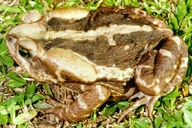|
Description
A large robust toad (adult male :100-166 mm; adult female : 135-190 mm). Body stout; strong cephalic crests and large parotoid glands on head. Tympanum small, higher than wide. Skin of dorsum scattered with blunt thorny warts, especially in males; dorsum yellowish in females and juveniles with a regular pattern of black blotches and a wide light-colored middorsal stripe. The color of the male dorsum is often a bright greenish yellow with only a few black blotches; belly white, marbled with brown.
Distribution and Habitat
Country distribution from AmphibiaWeb's database: Argentina, Brazil, Paraguay
The rain forest (Mata Atlântica) of southeastern and southern Brazil, eastern Paraguay, and also in Misiones (Argentina). Usually in elevated forests, also in grassland. During breeding time, they are found in streams and standing water bodies, such as lakes, ponds or puddles.Life History, Abundance, Activity, and Special Behaviors
Spawning period from August to January. In November and December hundreds of the diurnal, only 9-10 mm sized, recently metamorphosed froglets leave the breeding places en mass. Males call in and at water bodies, mainly at night but also during the day. The call is a melodious tremolo (pointed out by the indigenous name “Cururu”). The large egg strings with several thousand dark-colored eggs are deposited at shallow water. The small, black, free-swimming larvae live in large congregations, feeding on suspension and grazing on stones and aquatic plants. Most of adult toads are “Sit-and-Wait-Predators” feeding on invertebrates especially Coleoptera and Formicidae. Possible reasons for amphibian decline General habitat alteration and loss
Habitat modification from deforestation, or logging related activities
Local pesticides, fertilizers, and pollutants
Comments
Toads from the Eldorado locality, in Misiones, near the Paraná borders, show remarkable morphological peculiarities, with characters both of Rhinella (Bufo) schneideri, as the shape of the dorsal warts or the presence of tibial glands, and of Rhinella ictericus, as the parotoid shape or the dorsal pattern. More available biological data are needed to make clear the identity of such a mixed or intermediate population.
This species was featured in News of the Week October 18, 2021:
Amphibians are known for their very permeable skin that functions in gas and water exchange. Frogs, in particular, have colonized very dry habitats worldwide that would create seemingly conflict between the need for oxygen uptake (required for metabolism) and water loss (potential desiccation). To better understand how frogs, and especially their skin, cope with dry habitats, Mailho-Fontana et al. (2021) compared the skin, physiology, and behavior of two closely related toad species, the Yellow Cururu Toad and Cope's Toad (Rhinella icterica and R. jimi, which is now known as R. diptycha, respectively) that experience different climates. The authors found that the Cope's Toad from drier climate regions had thicker and more glandular skin, showed lower rates of water loss and displayed stereotyped behaviors to increase water uptake when dehydrated. These findings link differences in form, function, and behavior to illuminate strategies for desiccation resistance in frogs. (MWomack)
This species was featured in News of the Week 14 August 2023:
Amphibians are found across a wide range of elevations, from sea level to above 5,000 meters, exposing them to a wide range of climates. The climate variability hypothesis predicts that organisms exposed to more temperate variation will be able to function across a wider range of temperatures. Bovo et al. (2023) tested the thermal tolerances of five species of frogs that are distributed across mountains in Brazil's Atlantic Rainforest in a variety of microhabitats, including Boana faber, Dendropsophus minutus, Leptodactylus latrans, Physalaemus cuvieri, and Rhinella icterica. They found differences among species in temperature tolerance, but did not always find that broader temperature variation at increasing elevations correlated with broader temperature tolerance. In addition, they did not find a consistent difference in water loss or water uptake across altitude or climates. Overall, they did not find strong support for the climate variability hypothesis or for elevation shaping these physiological traits. (MWomack)
References
Beckmann, O. (2003). ''Reproduktion und Ernährung der Kröte Bufo ictericus im Waldschutzgebiet Pró-Mata, Araukarienplateau, Rio Grande do Sul, Brasilien.''
Cei, J. M. (1980). ''Amphibians of Argentina.'' Monitore Zoologica Italiano, New Series Monografia, Firenze, 2, 1-609.
Kwet, A. and Di-Bernardo, M. (1999). Anfíbios - Amphibien - Amphibians. EDIPUCRS, Porto Alegre.
Originally submitted by: Sabine Eger, Nalani Schnell & Mirco Sole (first posted 2004-05-27)
Edited by: Tate Tunstall, Michelle S. Koo (2023-08-13)Species Account Citation: AmphibiaWeb 2023 Rhinella icterica: Yellow Cururu Toad <https://amphibiaweb.org/species/200> University of California, Berkeley, CA, USA. Accessed Nov 24, 2024.
Feedback or comments about this page.
Citation: AmphibiaWeb. 2024. <https://amphibiaweb.org> University of California, Berkeley, CA, USA. Accessed 24 Nov 2024.
AmphibiaWeb's policy on data use.
|
